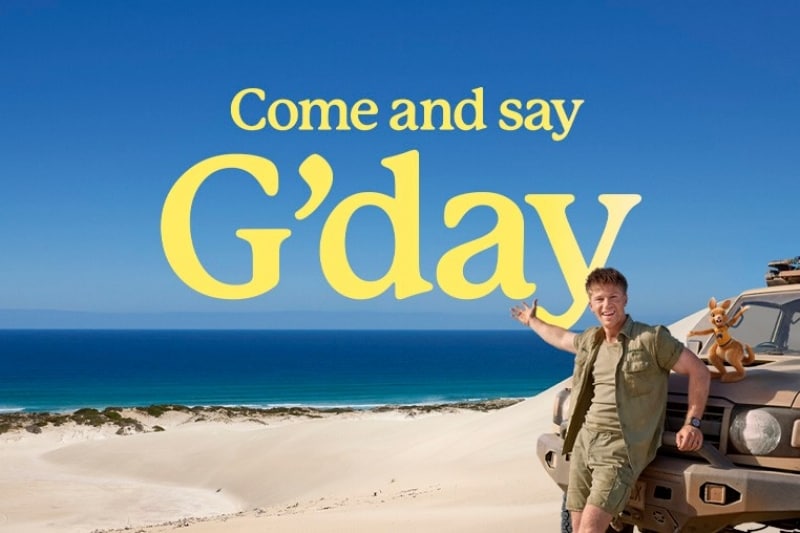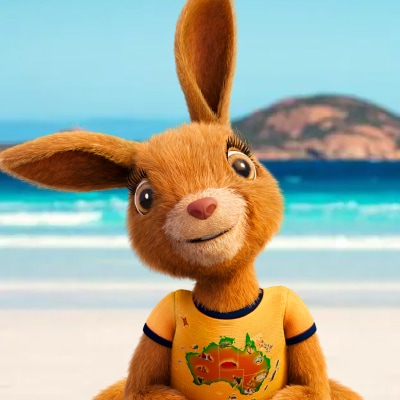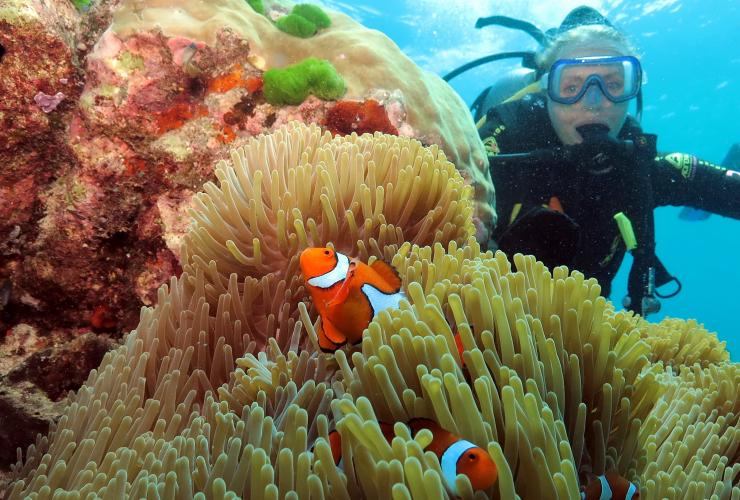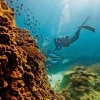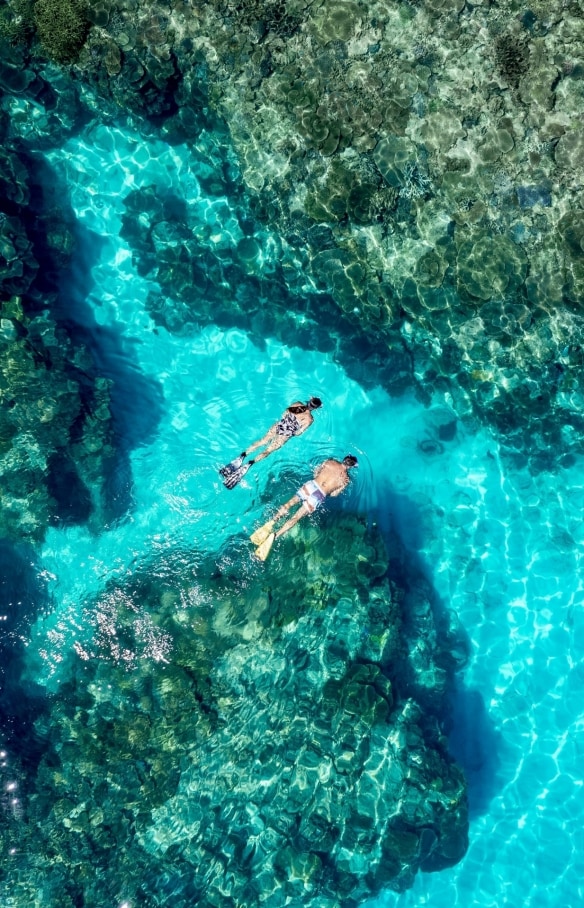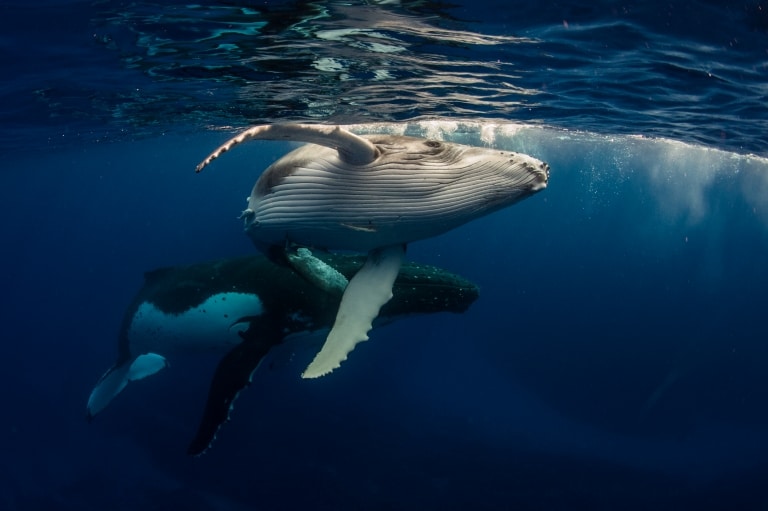
Humpback whales, Jervis Bay, New South Wales © Dive Jervis Bay
Swim with Australia’s most exciting marine life
From swimming with dolphins to snorkelling with whale sharks, plenty of “pinch me” moments await in Australian waters.
Float among a rainbow of fish
Float among a rainbow of fish
Australia’s reefs are abundant with brightly coloured fish, so you’re almost guaranteed to see more than a few on any snorkelling adventure. Dive in along the Great Barrier Reef to watch vibrant schools dart among the coral gardens. If you’re up for a challenge, try spotting every species included in the reef’s Great Eight marine encounters.
Sink into a crocodile enclosure
Sink into a crocodile enclosure
Saltwater crocodiles are one of Australia’s most intriguing marine predators. In fact, they’re the largest reptile on Earth. Luckily, Crocosaurus Cove in Darwin offers adrenaline junkies the chance to safely get up close and personal with the beasts. Standing in a glass cage, you’ll pull on your snorkel as you’re lowered into the water with a saltwater croc. Prepare to be amazed by its sheer size and agility.
Ride the currents with turtles
Ride the currents with turtles
While they’re not quite as easy to come by as colourful fish, sea turtles are very common along the warm, shallow reefs of Queensland and Western Australia. It’s an almost meditative moment as you watch these beauties drift lazily through the currents. You can try your luck at spotting them on a snorkelling tour, or head to Mon Repos from January to March to see the babies hatch and scamper away to the ocean.
Frolic with playful sea lions
Frolic with playful sea lions
Affectionately dubbed the ‘puppies of the sea’, friendly sea lions are one of Australia’s most interactive marine animals. Australian sea lions can be found playing in the waters and basking on the rocks of Western Australia and South Australia, but the Eyre Peninsula is your best bet for a meet and greet. Climb aboard a tour boat and head out to their known locations – their excitement is infectious as they rush over to say hello when you arrive.
Go swimming with dolphins
Go swimming with dolphins
Swimming with dolphins is a bucket-list-worthy moment for many – and for good reason. Once you join these curious mammals in the water, they will quickly adopt you as part of their pod. Port Stephens is one of the best places to swim among bottlenose dolphins in the wild. Book a tour and slide into the water, hanging onto the boat as it cruises along. Dolphins will arrive from below and beside to join you on your journey.
Glide with manta rays
Glide with manta rays
There’s nothing quite as majestic as witnessing a manta ray glide above you in the open ocean. The gentle rays can be found in several Aussie locations, but Lady Elliot Island takes the crown as their favourite underwater home, giving snorkelers the chance to observe their impressive wingspan and graceful, bird-like movements. Secure the best odds of seeing them by diving in during the winter months (June-August).
Float with giant cuttlefish
Float with giant cuttlefish
Displaying luminescent patterns and colours, giant cuttlefish leave a bizarre trail of drama everywhere they go. Each year, snorkelers are drawn to their Whyalla breeding grounds north of Adelaide, where they congregate in the thousands. Wade into the water on a guided tour and be hypnotised as these weird and wonderful creatures drift by, camouflaging their shape and colour to resemble their surroundings.
Splash around with whale sharks
Splash around with whale sharks
For an unforgettable sea life encounter, come mask-to-fin with the largest fish in the sea. Ningaloo Reef is a haven for underwater wildlife adventures and one of the only places in the world where whale sharks consistently congregate. Pull on your fins and paddle away from your tour boat to witness the sheer size and tranquillity of these enormous fish up close.
Breach the surface with humpback whales
Breach the surface with humpback whales
Joining humpback whales on their migration is a truly special experience, and in Australia, there are several places where you can try. Head to Queensland’s Hervey Bay to see the gigantic whales on their journey north from Antarctica. To ensure sustainable practices, getting in the water is done on the whale’s terms, so settle in to watch these breathtaking animals as your guide assesses their behaviour. If you’re fortunate enough to find a curious friend, you’ll climb into the sea and gently drift with the pull of the ocean as the whale glides by.
Take a dip with dwarf minke whales
Take a dip with dwarf minke whales
Embark on an exclusive, multi-day tour from Cairns to visit the only place in the world where you can dive with dwarf minke whales. Discovered in 1981, this not-so-little species of whale is one of the rarest marine animals to encounter in the wild. Heading off in search of them takes several days of snorkelling, making the satisfaction of finding them even sweeter. They are known to be very curious and love interacting with swimmers. Duck beneath the surface and watch as these rare whales inquisitively swim by.
Dive in with a dugong
Dive in with a dugong
Once thought to be real-life mermaids, dugongs are gentle and incredibly shy, making a chance encounter with them rare and exhilarating. Queensland’s Moreton Island and Western Australia’s Coral Coast are two of the best known places where dugongs can be seen drifting through the shallows. While a sighting can’t be guaranteed, the thrill of the chase is half the fun, and there is an abundance of other sea life to encounter in your search. If you do get the chance to see a dugong swimming by, you can forever revel in the status of being graced by the presence of these secretive creatures.
